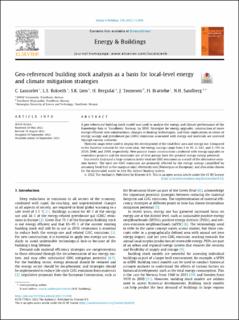Geo-referenced building stock analysis as a basis for local-level energy and climate mitigation strategies
| dc.contributor.author | Lausselet, Carine | |
| dc.contributor.author | Rokseth, Lillian Sve | |
| dc.contributor.author | Lien, Synne Krekling | |
| dc.contributor.author | Bergsdal, Håvard | |
| dc.contributor.author | Tønnesen, J. | |
| dc.contributor.author | Brattebø, Helge | |
| dc.contributor.author | Sandberg, Nina Holck | |
| dc.date.accessioned | 2022-12-05T09:28:04Z | |
| dc.date.available | 2022-12-05T09:28:04Z | |
| dc.date.created | 2022-10-03T09:18:11Z | |
| dc.date.issued | 2022 | |
| dc.identifier.issn | 0378-7788 | |
| dc.identifier.uri | https://hdl.handle.net/11250/3035796 | |
| dc.description.abstract | A geo-referenced building stock model was used to analyse the energy and climate performance of the Knowledge Axis in Trondheim, Norway, by 2050. Strategies for energy upgrades, construction of more energy-efficient new constructions, changes in heating technologies, and their implications in terms of energy savings and greenhouse gas (GHG) emissions associated with energy and materials are assessed through various scenarios. Thematic maps were used to display the development of the total floor area and energy use. Compared to the baseline scenario for the same year, the energy savings range from 2 to 9%, 2–14%, and 2–19% in 2030, 2040, and 2050, respectively. New passive house constructions combined with energy upgrades in renovation projects and the maximum use of heat pumps have the greatest energy-saving potential. Our results displayed a large variation in the total net GHG emissions as a result of the alternative emission factors. The total net GHG emissions are primarily affected by the energy savings (amplified by assuming fossil fuel as the marginal mix), electricity mix (Norwegian or European), and allocation chosen for the incinerated waste to feed the district heating system. | en_US |
| dc.language.iso | eng | en_US |
| dc.publisher | Elsevier Science | en_US |
| dc.rights | Navngivelse 4.0 Internasjonal | * |
| dc.rights.uri | http://creativecommons.org/licenses/by/4.0/deed.no | * |
| dc.title | Geo-referenced building stock analysis as a basis for local-level energy and climate mitigation strategies | en_US |
| dc.title.alternative | Geo-referenced building stock analysis as a basis for local-level energy and climate mitigation strategies | en_US |
| dc.type | Peer reviewed | en_US |
| dc.type | Journal article | en_US |
| dc.description.version | publishedVersion | en_US |
| dc.source.volume | 276 | en_US |
| dc.source.journal | Energy and Buildings | en_US |
| dc.identifier.doi | 10.1016/j.enbuild.2022.112504 | |
| dc.identifier.cristin | 2057644 | |
| dc.relation.project | Norges forskningsråd: 257660 | en_US |
| cristin.ispublished | true | |
| cristin.fulltext | original | |
| cristin.fulltext | original | |
| cristin.qualitycode | 2 |

